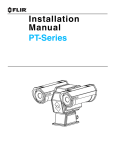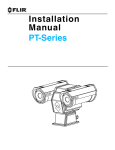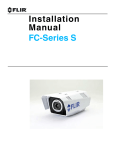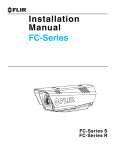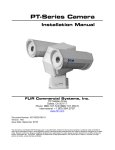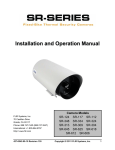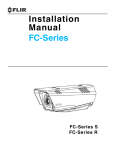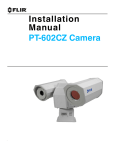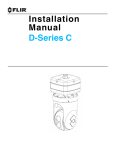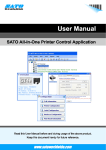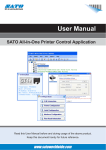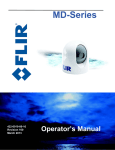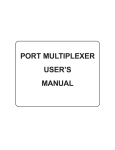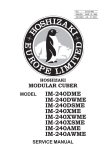Download F-Series - Installation Manual
Transcript
Installation Manual F-Series © 2013 FLIR Commercial Systems, Inc. All rights reserved worldwide. No parts of this manual, in whole or in part, may be copied, photocopied, translated, or transmitted to any electronic medium or machine readable form without the prior written permission of FLIR Commercial Systems, Inc. Names and marks appearing on the products herein are either registered trademarks or trademarks of FLIR Commercial Systems, Inc. and/or its subsidiaries. All other trademarks, trade names, or company names referenced herein are used for identification only and are the property of their respective owners. This product is protected by patents, design patents, patents pending, or design patents pending. The contents of this document are subject to change. FLIR Commercial Systems, Inc. 70 Castilian Drive Goleta, CA 93117 Phone: 888.747.FLIR (888.747.3547) International: +1.805.964.9797 http://www.flir.com Important Instructions and Notices to the User: Modification of this device without the express authorization of FLIR Commercial Systems, Inc. may void the user’s authority under FCC rules to operate this device. Modification of this device without the express authorization of FLIR Commercial Systems, Inc., may void the user’s authority under the FCC Rules to operate this device. Note 1: This equipment has been tested and found to comply with the limits for a Class A digital device, pursuant to part 15 of the FCC Rules. These limits are designed to provide reasonable protection against harmful interference when the equipment is operated in a commercial environment. This equipment generates, uses, and can radiate radio frequency energy and, if not installed and used in accordance with the instruction manual, may cause harmful interference to radio communications. Operation of this equipment in a residential area is likely to cause harmful interference in which case the user will be required to correct the interference at his own expense. Shielded cables must be used to connect this device to other devices. Note 2: If ferrites are supplied with this equipment, the equipment was tested for compliance with the FCC limits for a Class A digital device using power cables with the ferrites installed. When connecting one or two power cables to the equipment, the supplied ferrites must be used with this equipment. Industry Canada Notice: This Class B digital apparatus complies with Canadian ICES-003. Avis d’Industrie Canada: Cet appareil numérique de la classe B est conforme à la norme NMB-003 du Canada. Proper Disposal of Electrical and Electronic Equipment (EEE) The European Union (EU) has enacted Waste Electrical and Electronic Equipment Directive 2002/ 96/EC (WEEE), which aims to prevent EEE waste from arising; to encourage reuse, recycling, and recovery of EEE waste; and to promote environmental responsibility. In accordance with these regulations, all EEE products labeled with the “crossed out wheeled bin” either on the product itself or in the product literature must not be disposed of in regular rubbish bins, mixed with regular household or other commercial waste, or by other regular municipal waste collection means. Instead, and in order to prevent possible harm to the environment or human health, all EEE products (including any cables that came with the product) should be responsibly discarded or recycled. To identify a responsible disposal method where you live, please contact your local waste collection or recycling service, your original place of purchase or product supplier, or the responsible government authority in your area. Business users should contact their supplier or refer to their purchase contract. 427-0030-00-12, version 170 Mar 2014 ii Table of Contents Table of Contents F-Series Camera Installation 1.1 Warnings and Cautions ............................................................................................ 1-1 1.2 References ............................................................................................................... 1-1 1.3 Camera Overview ..................................................................................................... 1-1 1.4 Installation Overview ................................................................................................. 1-2 1.4.1 Camera Connection Options ............................................................................ 1-2 1.4.2 Supplied Components ..................................................................................... 1-2 1.4.3 Required Components ..................................................................................... 1-3 1.5 Location Considerations ........................................................................................... 1-3 1.5.1 Bench Testing .................................................................................................. 1-3 1.5.2 Prior to Cutting/Drilling Holes ........................................................................... 1-3 1.5.3 Camera Mounting ............................................................................................ 1-3 1.5.4 Removing the Back Cover ............................................................................... 1-4 1.5.5 Cable Gland Sealing ........................................................................................ 1-4 1.5.6 Cable Glands and Spare Parts Kit ................................................................... 1-5 1.5.7 Cable Gland Seal Inserts ................................................................................. 1-5 1.6 Camera Connections ................................................................................................ 1-6 1.6.1 Connecting power ............................................................................................ 1-6 1.6.2 Video Connection ............................................................................................ 1-7 1.6.3 Ethernet Connection ........................................................................................ 1-7 1.6.4 Serial Connection ............................................................................................ 1-7 1.7 Serial Communications Overview ............................................................................. 1-8 1.7.1 Serial Communications Settings - Hardware DIP Switches .............................. 1-8 1.8 F-Series Camera Specifications ............................................................................. 1-11 Basic Operation and Configuration 2.1 Nexus IP Camera ...................................................................................................... 2-1 2.1.1 Nexus Server Configuration ............................................................................. 2-1 2.1.2 Serial and/or IP Communications ..................................................................... 2-1 2.1.3 Serial Communications .................................................................................... 2-2 2.1.4 Ethernet Communications ................................................................................ 2-2 2.2 Bench Test ............................................................................................................... 2-2 2.2.1 Test and Configuration Steps ........................................................................... 2-3 2.3 Web Browser Interface ............................................................................................. 2-3 2.3.1 Log into the Camera Web Page ....................................................................... 2-4 2.3.2 Camera Control and Status .............................................................................. 2-5 2.3.3 Web Control Panel ........................................................................................... 2-6 2.3.4 Help ................................................................................................................. 2-7 2.3.5 Log Off ............................................................................................................. 2-7 2.4 Bench Test Using FSM ............................................................................................. 2-7 2.4.1 Running FSM ................................................................................................... 2-7 2.5 Basic Camera Configuration ................................................................................... 2-10 2.5.1 Expert and Admin Accounts ........................................................................... 2-10 2.6 Maintenance Menu ................................................................................................. 2-11 2.6.1 LAN Settings .................................................................................................. 2-12 2.6.2 Services (Date and Time Settings) ................................................................. 2-13 427-0030-00-12, version 170 Mar 2014 iii Table of Contents 2.6.3 Security Settings ............................................................................................ 2-14 2.6.4 Configuration File ........................................................................................... 2-15 2.7 Thermal Imaging Overview ..................................................................................... 2-16 2.8 Troubleshooting Tips .............................................................................................. 2-18 2.9 General Errors ........................................................................................................ 2-21 2.10 Restoring the Factory Settings .............................................................................. 2-23 2.11 Setting the IP address on a Windows PC .............................................................. 2-24 Serial Address: Decimal To Binary Conversion 3.1 Address Conversion Table ....................................................................................... 3-1 427-0030-00-12, version 170 Mar 2014 iv 1 F-Series Camera Installation This manual describes the installation of the F-Series cameras. If you need help during the installation process, contact your local FLIR service representative or, call 877-773-3547 inside the US. All installers and integrators are encouraged to take advantage of the training offered by FLIR; visit http://www.flir.com/training for more information. This manual includes the following topics: • • • • • • Installation overview Mounting the camera and its components Connecting the electronics Bench testing the camera Basic configuration and operation of the camera Camera Specifications For safety, and to achieve the highest levels of performance from the F-Series camera system, always follow the warnings and cautions in this manual when handling and operating the camera. 1.1 Warnings and Cautions Warning! If mounting the F-Series camera on a pole, tower or any elevated location, use industry standard safe practices to avoid injuries. Caution! Except as described in this manual, do not open the F-Series camera for any reason. Disassembly of the camera (including removal of the cover) can cause permanent damage and will void the warranty. Be careful not to leave fingerprints on the F-Series camera’s infrared optics. The F-Series camera requires a power supply of 24 Volts. Operating the camera outside of the specified input voltage range or the specified operating temperature range can cause permanent damage. 1.2 References F-SERIES Camera Mechanical Interface Control Document (ICD) (FLIR Doc # 427-0030-00-19) • Available on the documentation CD or from the FLIR website, provides further details regarding mechanical dimensions and mounting for the F-Series camera. Nexus IP Camera Configuration Guide (FLIR Doc # 427-0030-00-28) • 1.3 Available on the documentation CD or from the FLIR website, provides further details on using a web browser to configure the F-Series camera. Camera Overview The F-Series camera is both an analog and an IP camera. The video from the camera can be viewed over a traditional analog video network or it can be viewed by streaming it over an IP network using MPEG-4, M-JPEG and H.264 encoding. Analog video will require a connection to a video monitor or an 427-0030-00-12, version 170 Mar 2014 1-1 1 F-Series Camera Installation analog matrix/switch. The IP video will require a connection to an Ethernet network switch and a computer with the appropriate software for viewing the video stream. 1.4 Installation Overview The F-Series Camera is an infrared thermal imaging camera intended for outdoor applications, and can be installed in a fixed location or on a pan/tilt mechanism. Shipping plugs only Remove before installing Figure 1-1: F-Series Camera The F-Series camera is intended to be mounted on a medium-duty fixed pedestal mount or wall mount commonly used in the CCTV industry. Cables will exit from the back of the camera housing. The mount must support up to 30 lbs. (15 KG). 1.4.1 Camera Connection Options Camera connections are made through water-tight cable gland seals on the rear of the camera. Refer to section 1.5.5 “Cable Gland Sealing” on page 1-4 to ensure the glands are used correctly and the connections are properly sealed. The camera can be powered with a conventional power supply using 21 - 30 VAC or 21 - 30 VDC. The F-Series Camera can produce analog or digital (IP) video output (or both). Analog video will require a connection to a video monitor or an analog video matrix switch. An Ethernet connection is provided for IP video streaming and for command and control communications. A web browser can be used for camera configuration and maintenance (software/ firmware updates). On some models, a web browser can also be used for IP video streaming and for command and control. For analog installations that are not using Ethernet/IP, a serial cable (RS232 or RS422) can optionally be connected and used for command and control communications, supporting either Pelco D or Bosch protocols. In installations using analog video and serial communications, it is recommended an Ethernet cable should also be installed for camera configuration, operation, and troubleshooting. For installations where the camera is mounted on a tower or pole or other location that may be difficult to access, it is recommended the Ethernet connection should be installed from the camera down to ground level at a minimum, to allow easier access. 1.4.2 Supplied Components The F-Series camera includes these standard components: • • Fixed Camera Unit Cable Glands and Spare Parts kit 427-0030-00-12, version 170 Mar 2014 1-2 1 F-Series Camera Installation • • FLIR Sensors Manager CD F-Series Camera Documentation Package 1.4.3 Required Components The installer will need to supply the following items, which are specific to the installation. • Electrical wire, for system power; up to 100’ (3-conductor, shielded, gauge determined by cable length and supply voltage. Refer to section 1.6 “Camera Connections” on page 1-6. Camera grounding strap Coaxial RG59U video cables (BNC connector at the camera end) for analog video Shielded Category 6 Ethernet cable for control, streaming video, and for software upgrades. Optional serial cable for serial communications Miscellaneous electrical hardware, camera mount, connectors, and tools • • • • • 1.5 Location Considerations The camera will require connections for power, communications (IP Ethernet, and/or serial communications), and video. Important Note Install all cameras with an easily accessible Ethernet connection to support future software upgrades. Ensure that cable distances do not exceed the specifications and that cables adhere to all local and Industry Standards, Codes, and Best Practices. Important Note If the camera is to be mounted on a pole or tower or other hard-to-reach location, connect and operate the camera as a bench test at ground level prior to mounting the camera in its final location. 1.5.1 Bench Testing Connect the power, video, serial, and Ethernet connections and confirm that the video is displayed on a monitor when the power is turned on. For configuration and basic setup information using the onboard web server, refer to Basic Operation and Configuration on page 2-1. 1.5.2 Prior to Cutting/Drilling Holes When selecting a mounting location for the F-Series camera, consider cable lengths and cable routing. Ensure the cables are long enough, given the proposed mounting locations and cable routing requirements, and route the cables before you install the components. Use cables that have sufficient dimensions to ensure safety (for power cables) and adequate signal strength (for video and communications). 1.5.3 Camera Mounting F-Series cameras must be mounted upright on top of the mounting surface, with the base below the camera. The unit should not be hung upside down. The F-Series camera can be secured to the mount with three to five 1/4-20 threaded fasteners as shown below. 427-0030-00-12, version 170 Mar 2014 1-3 1 F-Series Camera Installation Not to scale Figure 1-2: F-Series Camera Mounting Holes Once the mounting location has been selected, verify both sides of the mounting surface are accessible. Use a thread locking compound such as Loctite 242 or equivalent with all metal to metal threaded connections. Once the holes are drilled in the mounting surface, install three (3) to five (5) 1/4-20 threaded fasteners into the base of the camera with thread-locking compound. 1.5.4 Removing the Back Cover Use a 3 mm hex key to loosen the four captive screws, exposing the connections at the back of the camera enclosure. There is a grounding wire connected between the case and the back cover as shown. If the grounding wire is temporarily disconnected during the installation, it must be reconnected to ensure proper grounding of the camera. 1.5.5 Cable Gland Sealing Proper installation of cable sealing glands and use of appropriate elastomer inserts is critical to long term reliability. Cables enter the camera mount enclosure through liquid-tight compression glands. Be sure to insert the cables through the cable glands on the enclosure before terminating and connecting them (the connectors will not fit through the cable gland). Leave the gland nuts loosened until all cable installation has been completed. Inspect and install gland fittings in the back cover with suitable leak sealant and tighten to ensure water tight fittings. Teflon tape or pipe sealant (i.e. DuPont RectorSeal T™) are suitable for this purpose. 427-0030-00-12, version 170 Mar 2014 1-4 1 F-Series Camera Installation 1.5.6 Cable Glands and Spare Parts Kit The kit contains the two 3/4” cable glands and gland seal plugs required for non-conduit installations. The remaining parts included in the kit are: • • • • • • a spare ground wire a spare ground nut and lock washer two spare power terminal block plugs two spare serial port terminal block plugs four spare F-Series back cover screws four spare PT-Series back cover screws 1.5.7 Cable Gland Seal Inserts The F-Series camera comes with two 3/4” NPT cable glands, each with a three hole gland seal insert. Cables may be between 0.23" to 0.29" OD. Typically up to five cables may be needed. Plugs are required for any insert hole(s) not being used. The photograph at the right shows two power cables, an Ethernet cable, a serial control cable (no analog video is installed), and two gland seal plugs. If non-standard cable diameters are used, you may need to locate or fabricate the appropriate insert to fit the desired cable. FLIR Commercial Systems, Inc. does not provide cable gland inserts other than the inserts supplied with the system. Ground Lug Camera Power Heater Power Serial Control Ethernet gland seal plugs Note Insert the cables through the cable glands on the enclosure before terminating and connecting them. In general, the terminated connectors will not fit through the cable gland. If a terminated cable is required, you can make a clean and singular cut in the gland seal to install the cable into the gland seal. 427-0030-00-12, version 170 Mar 2014 1-5 F-Series Camera Installation 1.6 Camera Connections Connections for Serial, Video, Ethernet, and Power Ethernet Heater Power 3 2 1 Male BNC RS422 Signals Chassis GND 24 VAC/DCEarth Ground 24 VAC/DC+ RS232 Signals 24 VAC/DCEarth Ground 24 VAC/DC+ RX+ GND TX+ 3 2 1 1 2 3 4 5 Camera Power RD(A)RD(B)+ GND TD(A)TD(B)+ 1 16 AWG Shielded 16 AWG Shielded 20 AWG MAX Back Cover 3/4” NPT for Cable Gland or Conduit Serial Communications RS232 or RS422 Left Cable Gland Right Cable Gland Analog Video Local Ground Ethernet 24 VAC/DC 24 VAC/DC Figure 1-3: Camera Connections 1.6.1 Connecting power The camera itself does not have an on/off switch. Generally the F-Series camera will be connected to a circuit breaker and the circuit breaker will be used to apply or remove power to the camera. If power is supplied to it, the camera will be in one of two modes: Booting Up or Powered On. The power cable supplied by the installer must use wires that are sufficient size gauge (16 AWG recommended) for the supply voltage and length of the cable run, to ensure adequate current carrying capacity. Always follow local building codes. Ensure the camera is properly grounded. Typical to good grounding practices, the camera chassis ground should be connected to the lowest resistance path possible. FLIR requires a grounding strap anchored to the grounding lug on the back plate of the camera housing and connected to the nearest earth-grounding point. Note The terminal blocks for power connections will accept a maximum 16 AWG wire size. 427-0030-00-12, version 170 Mar 2014 1-6 1 F-Series Camera Installation Camera Power Serial Connector for local control Heater Power Not used IP Network Analog Video Analog Video (monitoring output only) Figure 1-4: Connector and DIP Switch locations 1.6.2 Video Connection The analog video connection on the back of the camera is a BNC connector. The camera also provides an RCA video connector that can be used to temporarily monitor the video output, without disconnecting the BNC connection. The video cable used should be rated as RG59U or better to ensure a quality video signal. 1.6.3 Ethernet Connection The cable gland seal is designed for use with Shielded Category 6 Ethernet cable. 1.6.4 Serial Connection For serial communications, it is necessary to set the parameters such as the signalling standard (RS232 or RS-422), baud rate, number of stop bits, parity and so on. It is also necessary to select the communication protocol used (either Pelco D or Bosch) and the camera address. By default, the serial interface uses Pelco D, RS-422 standard, 9600 baud rate, 8/1/none, and address 1. Note Typical Bosch systems operate using a biphase connection and the FLIR cameras do not accept biphase signals directly. It may be necessary to install a biphase converter in order to use the Bosch protocol. Connect the wires of the serial cable as show in Figure 1-3 on page 1-6. When using the RS-422 standard, ensure the transmit pair of the camera goes to the receive pair of the other device, and vice versa. Note The terminal blocks for serial connections will accept a maximum 20 AWG wire size. 427-0030-00-12, version 170 Mar 2014 1-7 1 F-Series Camera Installation 1.7 Serial Communications Overview The installer must decide if the serial communications settings will be configured via hardware (DIP switch settings) or software. If the camera has an Ethernet connection, then generally it will be easier (and more convenient in the long run) to make configuration settings via software. Then configuration changes can be made over the network without physically accessing the camera. Also the settings can be saved to a file and backed up or restored as needed. If the camera is configured via hardware, then configuration changes in the future may require accessing the camera on a tower or pole, dismounting it, and removing the back and so on. If the camera does not have an Ethernet connection, the DIP switches must be used to set the serial communication options. Note The serial communications parameters for the F-Series camera are set or modified either via hardware DIP switch settings or via software, through a web browser interface. A single DIP switch (SW102-9), Software Override determines whether the configuration comes from the hardware DIP switches or the software settings. Note The DIP switches are only used to control serial communications parameters. Other settings, related to IP camera functions and so on, must be modified via software (using a web browser). 1.7.1 Serial Communications Settings - Hardware DIP Switches The camera has two blocks of DIP switches that are used to configure the serial communications settings. One block of switches has 8 switches and is used to set the serial address (or ID) of the camera. The other block of switches has 10 switches and is used to set baud rate, hardware protocol (RS-232 or RS-422), serial protocol (Pelco D or Bosch), and Software Override. The figure below shows the locations of dip switches SW101 and SW102. SW102 SW101 Switch Position Off On Software Override Switch Figure 1-5: F-Series Camera Configuration 427-0030-00-12, version 170 Mar 2014 1-8 1 F-Series Camera Installation If the Software Override DIP switch is set to the software position (as it is by default), all of the other DIP switches will be ignored, and configuration changes must be made through software. If the switch is set to the hardware position, all configuration settings related to serial communications are made with the DIP switches, and changes that are made via software (with a web browser) will be ignored. The following image shows the factory default settings, with address 1, 9600 baud, Pelco D, RS-422, Software Override set to software: Serial Address: Use the block of switches on the left (SW101) to set the serial address of the camera. The available range of values is from decimal 1 to 255. The dip switches are interpreted as a binary number, with switch 1 representing the least significant bit (the switches are in the reverse order of the bits). For convenience, a table of serial addresses and their binary equivalents is included at the end of the manual. See “Serial Address: Decimal To Binary Conversion” on page 3-1. Table 1-1: Dip Switch Address/ID Settings—SW101 ID Sw 1 LSB Sw 2 Sw 3 Sw 4 Sw 5 Sw 6 Sw 8 MSB Sw 7 1 On Off Off Off Off Off Off Off 2 Off On Off Off Off Off Off Off 3 On On Off Off Off Off Off Off … … … … … … … … … 255 On On On On On On On On Other Serial Communication Parameters: The tables below defines the switch locations, bit numbering and on/off settings used in controlling the other serial communication parameters. Table 1-2: Dip Switch Settings—SW102 Settings Baud Rate: This is the baud rate of the system user serial port. The available values are 2400, 4800, 9600, 19200 kbaud. 427-0030-00-12 Rev170 Mar 2014 Description Bit 1 Bit 2 Off Off 2400 On Off 4800 Off On 9600 On On 19200 1-9 1 F-Series Camera Installation Table 1-2: Dip Switch Settings—SW102 Settings Camera Control Protocol: This is the communication protocol selected for the system when operating over the serial port. The available protocols are Pelco-D and Bosch. Serial Communication Standard: This determines the electrical interface selected for the user serial port. The available settings are RS422 and RS232. Not Used Software Override DIP Switch: This setting determines whether the system will use software settings for configuration or if the dip switch settings will override the software settings. Default is Off. Bit 3 Bit 4 Off Off Pelco-D On Off NA Off On Bosch On On NA Bit 5 Bit 6 Off Off NA On Off RS422 Off On RS232 On On NA Bit 7 Bit 8 X X X X X X X X Bit 9 Off Software select On Hardware select Bit 10 Not Used 427-0030-00-12, version 170 Description X Mar 2014 1-10 1 F-Series Camera Installation 1.8 F-Series Camera Specifications THERMAL CAMERA SPECS Resolution 160 x 120 Detector Type Long-Life, Uncooled VO× Microbolometer Pixel Pitch 25 μm 25 μm 17 μm Focal Length (lens/model dependent) 9 mm, 13 mm, 19 mm 9 mm, 13 mm, 19 mm, 35 mm, 65 mm, 100 mm 13 mm, 25 mm, 35 mm, 50 mm, 65 mm, 100 mm Field Of View (lens/model dependent) 24° × 20° (F-124; 9 mm) 17° × 14° (F-117; 13 mm) 12° × 10° (F-112; 19 mm) 48° × 39° (F-348; 9 mm) 34° × 28° (F-334; 13 mm) 24° × 19° (F-324; 19 mm) 13° × 10° (F-313; 35 mm) 7° × 5° (F-307; 65 mm) 4.6° × 3.7° (F-304; 100 mm) 45° × 37° (F-645; 13 mm) 25° × 20° (F-625; 25 mm) 18° × 14° (F-618; 35 mm) 12° × 10° (F-612; 50 mm) 10° × 8° (F-610; 65 mm) 6.2° × 5° (F-606; 100 mm) Zoom (model dependent) 2× E-zoom 2× & 4× E-zoom 2× & 4× E-zoom 320 x 240 Continuous e-zoom on F-6xxE models Spectral Range Focus Range 640 x 480 Athermalized, focus-free OUTPUTS Composite Video NTSC or PAL Standard Video Over Ethernet Two independent channels of streaming MPEG-4, H.264, or M-JPEG CONTROL Point To Point (stand alone) Standard Ethernet Standard Serial RS-232/-422; Pelco D, Bosch Network Enabled Standard GENERAL Weight 9.5 lb (configuration dependent) Dimensions (L,W,H) 18.1” × 5.5” × 6.3” (460 mm × 140 mm × 160 mm) Power Requirements 24 VAC (21-30 VAC) 24 VDC (21-30 VDC) Power Consumption 24 VAC: 15 VA max no heater, 51 VA max w/heater 24 VDC: 10 W max no heater, 46 W max w/heater Inrush Current <5 A for DC power supply with slew rate > 10 ms <19 A for AC power supply with slew rate > 4.17 ms ENVIRONMENTAL Dust, Water Protection Rating IP66 Operating Temperature Cold start -50°C to +70°C (-58°F to +158°F); -40°C to +70°C (-40°F to +158°F) Note Power consumption is independent of the input voltage when the heater is off. The power drawn by the heaters increases with the input voltage to a maximum at 30 Volts. 427-0030-00-12 Rev170 Mar 2014 1-11 1 F-Series Camera Installation 427-0030-00-12, version 170 Mar 2014 1-12 2 Basic Operation and Configuration This chapter provides basic information on how to operate a new camera that has not yet been configured. A bench test can be used to verify camera operation before the camera is configured for the local network. This chapter also provides basic configuration information. 2.1 Nexus IP Camera TheF-Series camera is an IP camera with Nexus capabilities, which means there is a microprocessor inside that runs the Nexus Server software. The Nexus Server provides a number of services, including camera control, video streaming, and geo-referencing capabilities. The Nexus communications protocol is an open, standards-based protocol that allows the server to communicate with a video management client, such as FLIR Sensors Manager or with a third-party ONVIF-compatible VMS client. There are two main components to the Nexus Server software. One is a web server known as the web tool or web interface that listens on the network for web browser requests, and is used for the initial (and perhaps ongoing or occasional) configuration changes to the server. The latest release of the web tool also allows the user to view video and to operate the camera. The other process, known as the Nexus Server, listens on the network for connections from clients such as FSM or other VMS clients. These clients are used to control the camera and stream video during dayto-day operations of the camera. 2.1.1 Nexus Server Configuration In general, it may be necessary for the installer to make a limited number of configuration changes for each server, such as setting the serial and/or IP communication parameters. For example, each camera comes from the factory with the same default IP address, so adding more than one camera to an IP network requires each camera to be configured with a different IP address, at a minimum. On the other hand, many of the configuration parameters will remain unchanged from the factory default settings. In order to control the camera, it is necessary to communicate with it either using serial communications (RS-232 or RS-422), or over Ethernet using Internet Protocol (IP). In either case, it is likely there are some communication parameters that are specific to each installation. 2.1.2 Serial and/or IP Communications For a camera that is installed in a legacy-type CCTV network using analog video, the camera may commonly be controlled with serial communications. The serial cable from the camera will be connected to a keyboard/joystick device, or to a video switch, encoder, or DVR that has a serial communication port. In this case the installer may want to configure parameters such as the address of the camera, the baud rate, and so on. On Nexus IP cameras that support serial communications, these parameters can be set through software using a web browser. For a camera installed in an IP network, the camera will commonly be controlled over Ethernet by a PC or laptop running FLIR Sensors Manager (FSM) or a third-party Video Management System (VMS) software. FSM is an integral part of the Nexus architecture—it is a client program that communicates with the Nexus Server on the camera. It allows control of the camera and video streaming and many other sophisticated functions. In many cases, a camera will be installed with both serial and Ethernet communications. As such, the camera can be controlled by means of a serial device or through software. When someone tries to control the camera with a serial device at the same time as someone does through the software IP interface, the serial device takes priority. 427-0030-00-12, Version 170 Mar 2014 2-1 2 Basic Operation and Configuration Not all parameter settings are described in this manual. If you need help during the configuration process, contact your local FLIR representative or, call 888-747-3547 inside the US. 2.1.3 Serial Communications Cameras that have a serial interface support a limited set of pan/tilt/zoom and focus commands over RS-422 or RS-232 serial communications using common protocols (Pelco D or Bosch). By default, the camera is configured for RS-422 standard, 9600 Baud, 8 bits, no parity, 1 stop bit, using the Pelco D protocol, and address 1. 2.1.4 Ethernet Communications The camera has an Ethernet connection that allows streaming video over an IP network as well as configuration and control of the camera1. It is possible to stream video and control the camera as it is from the factory, without making any configuration changes. However in most cases the camera will have at least some configuration changes to allow it to connect with other devices on the existing network. Once the camera is connected to a network and powered on, the user can choose to use either a web browser2 or the FLIR Sensors Manager (FSM) software to view the video and control the camera. The FSM software is included with the camera and can be run under Microsoft Windows. Refer to the FSM User Manual for details about using the software; the manual is available from the Windows Start menu once the software is installed. With the latest version of camera firmware, a web browser can be used to operate the camera (view video, pan/tilt/zoom, and so on) and it can be used to make configuration changes. This manual has basic configuration information; refer to the Nexus IP Camera Configuration Guide (FLIR Doc. 4270030-00-28) for more details about camera configuration. If the camera will be controlled only through serial communications, it may still be necessary to connect it to an IP network, at least temporarily, to adjust any of the serial communications settings. By default, the serial interface uses the Pelco D protocol, RS-422 standard, 9600 baud rate (8/none/ 1), and address set to 1. Refer to the Nexus IP Camera Configuration Guide for information on changing these parameters. Getting the camera IP interface set up and working may require a level of familiarity with managing IP networks that is new to many security professionals. Prior to configuring the IP interface and streaming video parameters, make sure you know how to manage and configure the other equipment in the network (for example, any PC or device that will connect to the camera, any router or firewall that will carry the IP traffic, and so on). FLIR technical support can only provide limited support in this regard. 2.2 Bench Test Since the camera offers both analog video and IP video, there are several ways to bench test the camera. It is recommended the installer should test the camera using the same type of connections as the final installation. 1. For this chapter, it is assumed the camera will be connected to a network via Ethernet. For installations that use only analog video output, it is not possible to make configuration changes unless an Ethernet connection is also used. 2. The web interface is supported on Microsoft Internet Explorer version 9, as well as the latest versions of Google Chrome and Mozilla Firefox®. 427-0030-00-12, Version 170 Mar 2014 2-2 2 Basic Operation and Configuration Even if using analog video and serial communications in the final installation, it is a good idea to test the IP communications when performing the bench test. If any image adjustments are necessary, they can be done using a web browser over the IP connection, and saved as power-on default settings. With the camera powered up, analog video can be tested at the BNC connectors. Connect the camera video output to a video monitor and confirm the live video is displayed on the monitor. If using serial communications, connect the serial cable from the camera to a serial device such as a keyboard, and confirm that the camera is responding to serial commands. Before using serial communications, it may be necessary to configure the serial device interface to operate with the camera. When the camera is turned on, the video temporarily displays system information including the serial number, IP address, Pelco address, and the Baud rate. For example: S/N: 1234567 IP Addr: 192.168.250.116 PelcoD (Addr:1): 9600 SW 2.2.1 Test and Configuration Steps Assuming the existing network uses IP addresses that are unique and different than the default address on the camera, configuring the camera for IP communications generally involves the following steps: Step 1 Step 2 Step 3 Step 4 Step 5 Step 6 Step 7 Step 8 2.3 Connect the Ethernet port to an IP network that is isolated from the existing camera network (for example, a standalone switch) Connect a PC or laptop to the same network Temporarily set the IP address of the PC or laptop to be compatible with the factory network address of the camera (for example, 192.168.250.1) If you are unsure how to set the IP address on the PC or laptop, refer to section 2.11 “Setting the IP address on a Windows PC” on page 2-24. Perform a bench test of the camera using FSM, prior to making any parameter changes (this step is optional but recommended) Using a web browser, configure the camera settings, such as IP address, camera date/ time, and other parameters, so the camera is compatible with the existing network equipment Save the configuration changes and restart the server Connect the camera to the existing network and test the camera Make a backup of the new configuration Web Browser Interface Use a web browser to connect to the camera as described below, and confirm it is streaming video. Once the bench test is complete, use the web browser to make configuration changes as needed (for example, set the IP address to an address that is compatible with the existing network). It is also a good idea to run the FSM software and confirm it is working with the camera as expected. It is possible to log into the camera using one of three User Names: user, expert, and admin (the corresponding passwords by default are user, expert, and fliradmin respectively). The user login can be used to do the initial bench test of the camera. The admin login must be used to make configuration changes such as setting the IP address. The login passwords can (and should) be changed by the system administrator to prevent unauthorized access. For information on how to change the passwords, refer to section 2.6 “Maintenance Menu” on page 2-11. 427-0030-00-12, Version 170 Mar 2014 2-3 2 Basic Operation and Configuration 2.3.1 Log into the Camera Web Page Step 1 Open a web browser and enter: http:\\192.168.250.116. The login screen with a picture of the camera will appear. Enter user for the User Name and user for the Password, and click Login. Step 2 The Live Video page will be displayed, with a live image from the camera on the left part of the screen. Next to the FLIR logo along the top of the screen are some menu choices, including Live Video (the red text indicates it is selected), Help and Log Off. On the right side are some control buttons, and possibly an image of a joystick (if the camera has pan/ tilt capability). Figure 2-2: Camera Web Page Login Screen 427-0030-00-12, Version 170 Mar 2014 2-4 2 Basic Operation and Configuration If the live video is not displayed, refer to section 2.8 “Troubleshooting Tips” on page 2-18. In the lower right of the web page there is a frame rate selector. This selector allows the user to change the rate at which the frames are displayed in the browser. This rate controls the user’s own web browser only, and does not affect the video streams to other users or to an NVR. Note Before making any configuration changes, it may be wise to back up the existing configuration. Refer to section 2.6.4 “Configuration File” on page 2-15 for information about the configuration file. 2.3.2 Camera Control and Status In the lower left of the screen are two indicator “lights”: Control and Status. Initially the Control light is off, as in the image above, indicating the user is not able to control the camera immediately. When multiple users are connected to a camera, only one user at a time can issue commands to the camera. If another user has control of the camera, the Control light is yellow. A user is able to request control of the camera by clicking on the yellow or black “light”, or simply by sending a command to the camera. For example, move the cursor over the video and select the “Zoom In” control (magnifying glass with “+”) that appears in the lower left of the screen. The Status light may turn off temporarily while waiting for the response from the camera. After a short pause, the Control light should turn green. Observe what happens to the image when the “Zoom In” control is clicked several times. Be patient, there may be a slight delay between each command while the browser waits for a response from the camera. If a command is sent to the camera when the user does not have control, the command will not be executed, and it is necessary to send the command again once the light is green. 2.3.3 Web Control Panel The control buttons on the right side of the page provide a way to control the camera. When the mouse cursor is positioned over a button, a screen tip is displayed which explains the function of the button. This same web interface is used with various FLIR thermal cameras; some are fixed mount cameras, such as the F-Series and FC-Series S cameras, and some have pan/tilt capabilities, such as the PT-Series and D-Series. As a result, some buttons appearing in the control panel may be disabled if they do not apply to the camera in use. Save Snapshot This button allows the user to save an image as a .jpg file. The destination folder for the image is determined by the web browser that is used. Perform IR NUC Calibration This button causes the camera to perform a Non-Uniformity Correction operation (refer to the section “Image freezes momentarily” on page 2-18). 427-0030-00-12, Version 170 Mar 2014 2-5 2 Basic Operation and Configuration Toggle Scene Preset This button causes the camera to cycle through 5 different image settings. The Scene Presets cause the image brightness and contrast to adjust. Depending on the time of day, weather, and other conditions, one Scene Preset may be preferable to the others. Toggle Polarity This button changes the way various objects are displayed in the image, with hot objects displayed as white and cold objects as black, or vice versa. Function Some cameras have additional features or functions which can be accessed using an extra numeric function keypad. It is possible to create customized camera functions through a “macro” interface which can be programmed through XML commands. For additional information contact FLIR Technical Support for information about the Nexus XML-Based Control Interfaces. When the Function button is selected, the keypad changes to a numeric keypad. As digits are selected, they are displayed below the keypad. To execute the function, select the FN Function button again. If an invalid function is entered, an error message appears below the video window (“Function is not available in current mode.”). To return to the Control Panel, select the Back button (left arrow). Other buttons on the control panel may be disabled if not available for the camera. In the control panel, a disabled button is indicated with a grey color and when the cursor is positioned over a disabled button, the screen tip indicates the function is not available. 2.3.4 Help At the top of the page, select the Help menu to display software version information. This page has information about the camera including hardware and software revision numbers, part numbers, and serial numbers. If it is necessary to contact FLIR Technical Support for assistance, it will be helpful to have the information from this page (such as Software Version) on hand. 2.3.5 Log Off Use the Log Off menu entry to disconnect from the camera and stop the display of the video stream. 2.4 Bench Test Using FSM IF FSM is to be used in the final installation, it is a good idea to perform a bench test with it, as described below, prior to making configuration changes. The FSM software is included with the camera; the software installation will begin automatically when the CD is inserted into the PC. Once the bench test is complete, use a web browser to make configuration changes as needed (for example, set the IP address to an address that is compatible with the existing network). The following provides a brief description of how to use FSM to control a camera and stream video from the camera. For more detailed information on how to use FSM, refer to the FLIR Sensors 427-0030-00-12, Version 170 Mar 2014 2-6 2 Basic Operation and Configuration Manager User Manual. Once the software is installed, the manual is available from the Windows Start Menu. If the FSM software has not been installed yet, locate the CD that came with the camera and install it on the PC. The latest version of the software is also available from http://support.flir.com/ in the Downloads page. 2.4.1 Running FSM Run the FSM software by double clicking the FLIR Sensors Manager icon on the desktop, or click on the Windows Start button and select Programs > FLIR Sensors Manager > FLIR Sensors Manager. Initially the FLIR Sensors Manager splash screen will be displayed. After a brief while, the FSM main window will appear. A popup FSM Notification window will appear in the lower right of the screen indicating that no cameras (servers) have been discovered yet. Click on the Accept button to acknowledge the notification. The FLIR Sensors Manager uses a “client/server” architecture. The FSM software is considered a client, and the cameras are considered servers or sensors. The Sensors Panel in the upper left of the window indicates no sensors have been discovered and added to the list of Active Sensors. No sensors discovered initially Control Panel Pan/Tilt/Zoom controls Video Wall 0 Refresh Setup Discovery Move to Active Sensors Click on Setup, if required, then the Discovery button on the side panel to bring up the Discovery Panel. The FSM software can automatically discover FLIR cameras on the network. 427-0030-00-12, Version 170 Mar 2014 2-7 2 Basic Operation and Configuration When the Discovery Panel is displayed, click Refresh. The FLIR camera will appear in the list of Discovered Sensors. The camera will be called “FLIR”, and the asterisk in parenthesis “(*)” indicates the camera has not been added to the list of Active Sensors on the right. Click on the center bar “>” to move the camera over to the list of Active Servers. The name of the camera should appear in the Sensors Panel, with a green joystick icon. By default, the FSM software will automatically discover sensors in the network, connect to the first camera it finds, take control of the camera, and display the video from the camera in Video Wall 0. Click on Video Wall 0 and confirm that video is streamed to the monitor and it is possible to control the camera using the pan/tilt/zoom controls in the Control Panel. For example, click on the zoom button (magnifying glass with +), and the video will zoom to 2X. Once operation of the camera has been confirmed, the camera can be configured to an IP address that matches the installation network. 427-0030-00-12, Version 170 Mar 2014 2-8 2 Basic Operation and Configuration 2.5 Basic Camera Configuration The following procedures describe how to do the most common basic camera configuration steps, such as setting the camera IP address and hostname and changing the user passwords. To make these changes, it is necessary to login using the admin user account. Note In most installations, the only camera settings needed are available from the Live Video page (using Scene Presets or Polarity). Use caution when modifying the camera settings described in this section. Some settings may adversely affect the thermal image over time or may completely disable the camera or the network interface. 2.5.1 Expert and Admin Accounts When a user logs in as expert, an additional menu called Setup is available. The Setup menu can be used to make advanced adjustments to the thermal camera. For a pan/tilt camera, it can also be used to make configuration changes to the daylight camera and the pan/tilt platform. These adjustments should only be made by someone who has expertise with thermal cameras and a thorough understanding of how the various settings affect the image. Haphazard changes can lead to image problems including a complete loss of video. When a user logs in as admin, a third menu called Maintenance is available. It is possible to use settings on the Maintenance menu to modify the network settings, including the IP address of the camera. It is also possible to use the Maintenance menu to change the login passwords. The Maintenance menu also provides access to many other configuration options. 427-0030-00-12, Version 170 Mar 2014 2-9 2 Basic Operation and Configuration 2.6 Maintenance Menu Initially, when the Maintenance page is selected, the Server Status page is displayed. The page provides an indication of the current server status (either running or stopped) and buttons for starting or stopping the server or for rebooting the system. Note, In order to make some configuration changes through the Maintenance menu, it is necessary to save the changes, then stop and restart the server to make the changes take effect. The basic camera configuration steps are accessed through the Maintenance menu, using the Server submenu on the left side of the page.The LAN Settings, Services, and Security Options selections are described below. Generally with these settings it is necessary to save the changes to make them effective, but it is not necessary to stop and restart the server. Step 1 Step 2 Step 3 If you are logged into the Nexus Server User account, select Log Off or direct your web browser to: http:\\192.168.250.116. Enter admin for the User Name and fliradmin for the Password, and click Login. Select Maintenance from the top menu. The following Server Status page appears. 427-0030-00-12, Version 170 Mar 2014 2-10 2 Basic Operation and Configuration 2.6.1 LAN Settings The LAN Settings page can be used to set the hostname, default gateway, and IP address for the camera. The default IP Address mode is static; the mode can also be set to DHCP. Once the IP address of the camera is changed, the PC may no longer be on the same network and therefore may not be able to access the camera until the IP address on the PC is changed also. For that reason, you may wish to change the IP address after making other configuration changes. When the LAN settings are changed and the Save button is clicked, a pop-up message will appear to indicate the network interface should be restarted. Once all the changes have been made and saved, click on the Restart Network button at the bottom of the page. If the Hostname is changed, the new name may not show up in FSM until the camera is rebooted. To reboot the camera, save any configuration changes, then select Server Status and click the Reboot button. Note The IP address is temporarily displayed on the video for a short while after the camera boots up. If you are unsure what the camera IP address is set to, it may useful to reboot the camera and watch for the IP Address information after the camera boots up. To reset the IP address (and other configuration settings and login passwords) to the factory default, refer to section 2.10 “Restoring the Factory Settings” on page 2-23. 427-0030-00-12, Version 170 Mar 2014 2-11 2 Basic Operation and Configuration 2.6.2 Services (Date and Time Settings) The Services page is used to configure the date and time settings. The date, time, and time zone can be obtained from an NTP server, or can be entered manually. If the NTP mode is selected, the NTP server information can be entered. The NTP server address can be entered as a static address or can be obtained via DHCP. If the Custom mode is selected, a pop-up window allows the information to be entered manually. Set the date and time parameters, then select the Save button at the bottom. 427-0030-00-12, Version 170 Mar 2014 2-12 2 Basic Operation and Configuration 2.6.3 Security Settings To maintain security of your systems set passwords for each of the three login accounts. user —The user account can only use the Live Video screen and controls. expert —The expert account can use the Live Video screen and the camera Setup screen. admin —The admin account can use all screens After each password is set and confirmed, select the Save button at the bottom (it may be necessary to scroll down the page). Note, as an additional security measure, it is possible to limit which computers have access to the web browser interface. At the top of the page under “Restrict Web Configuration”, add a computer’s IP address and click “Add”. After all the allowed IP addresses are entered, select the Save button to save the changes. Note, once one or more addresses has been added to this list, only these computers will be able to log in to the web interface. Be sure to remember which addresses are allowed. 427-0030-00-12, Version 170 Mar 2014 2-13 2 Basic Operation and Configuration It is also possible to limit access to the camera from a client program (such as FSM) by IP address. To do so, in the Maintenance menu select Sensor, then Networking. Set the “Allow anonymous clients” parameter to No, and then add in the allowed addresses in the Remote Clients list and click Save. Note, once one or more addresses has been added to this list, only these computers will be able to access the camera as a client. Be sure to remember which addresses are allowed. 2.6.4 Configuration File The Configuration File option on the Files web page allows the Nexus Server configuration to be displayed or backed up locally (on the camera). The configuration file can also be downloaded to another computer for backup, or a new configuration file can be uploaded from a computer to the camera. Shown at the top of the screen is the configuration script file in a scrollable window. This can be useful if you ever need help from a support engineer. In the Custom Backup & Recovery section, click the Restore link associated with the factory.defaults configuration to restore the camera to its factory settings. This file can not be modified or deleted, so it is always available. Use the Backup button to make a backup of your final settings. This will make a backup copy of the configuration file and store it locally on the camera. In the Upload & Download section, the Download Configuration File link can be used to save a copy to a PC for safe keeping. A pop-up window will ask for a file name and destination folder. The Upload button is used to transfer a configuration file from a PC to the camera. 427-0030-00-12, Version 170 Mar 2014 2-14 2 Basic Operation and Configuration 2.7 Thermal Imaging Overview When power is applied to the F-Series camera, a FLIR splash screen is displayed for less than two seconds, and then the camera outputs the live video image. No operator action or intervention is required and no configuration of the camera is necessary. The thermal camera makes an image based on temperature differences. In the thermal image, by default the hottest item in the scene appears as white and the coldest item is black, and all other items are represented as a grey scale value between white and black. Figure 2-3: Splash Screen It may take some time to get used to the thermal imagery from the camera, especially for someone who only has experience with normal daylight cameras. Having a basic understanding of the differences between thermal and daylight cameras can help with getting the best performance from the thermal camera. Both thermal and daylight cameras have detectors (pixels) that detect energy. One difference between thermal and daylight cameras has to do with where the energy comes from to create an image. When viewing an image with an ordinary camera, there has to be some source of visible light (something hot, such as the sun or lights) that reflects off the objects in the scene to the camera. The same is true with human eyesight; the vast majority of what people see is based on reflected light energy. On the other hand, the thermal camera detects energy that is directly radiated from objects in the scene. Most objects in typical surroundings are not hot enough to radiate visible light, but they easily radiate the type of infrared energy that the thermal camera can detect. Even very cold objects, like ice and snow, radiate this type of energy. The camera is capable of sensing very small temperature differences, and produces a video image that typically has dramatic contrast in comparison to daylight cameras. This high contrast level from the thermal video enables intelligent video analytic software to perform more reliably. The performance of the camera will likely vary throughout the day. Right after sunset, objects warmed by the sun will appear warmest. Early in the morning, many of these objects will appear cooler than their surroundings, so be sure to look for subtle differences in the scene, as opposed to just hot targets. Originally developed for the military, thermal imaging cameras are now deployed in numerous commercial applications where it is impractical or too expensive to use active illumination (lights). 427-0030-00-12, Version 170 Mar 2014 2-15 2 Basic Operation and Configuration They are perfect for a wide variety of applications including transportation, maritime, security, fire fighting, and medical applications. The cameras often provide improved daytime viewing in environments where traditional video camera performance suffers, such as in shadows or backlit scenes. The F-Series camera is a state-of-the-art thermal imaging system that will provide excellent night visibility and situational awareness, without any form of natural or artificial illumination. The system is easy to use, but it is useful to understand how to interpret what is displayed on the monitor. While the imagery on the monitor may at first look similar to ordinary black and white daylight video, experience with the camera in varying conditions and seasons will lead to an appreciation of the characteristics that make thermal imaging distinct. A few tips on how to interpret some of the imagery may help you to make the most of your system. The thermal camera does not sense light like conventional cameras; it senses heat or temperature differences. The camera senses small “differences” in apparent radiation from the objects in view, and displays them as either white (or lighter shades of grey) for warmer objects, and black (or darker shades of grey) for colder objects. The thermal imaging camera relies on the fact that all objects, even very cold objects like ice, emit thermal energy in the portion of the infrared spectrum that this camera can “see”, the long wave infrared (LWIR). Therefore, unlike an illuminated infrared camera, a thermal camera does not need an additional active illumination source, and creates video based on directly radiated rather than reflected energy. This is why hot objects such as parts on an engines and exhaust pipes appear white, while the sky, puddles of water and other cold objects appear dark (or cool)3. Scenes with familiar objects will be easy to interpret with some experience. The camera automatically optimizes the image to provide you with the best contrast in most conditions. 3. By default, the camera represents hot objects as white and cold objects as black. The camera can be set to use the Black Hot polarity setting, which displays hot objects as black and cold objects as white and is effectively the negative of White Hot polarity. 427-0030-00-12, Version 170 Mar 2014 2-16 2 Basic Operation and Configuration 2.8 Troubleshooting Tips If you need help during the installation process, contact your local FLIR representative or, call 877773-3547 inside the US. FLIR Systems, Inc. offers a comprehensive selection of training courses to help you to get the best performance and value from your thermal imaging camera. Find out more at the FLIR training web page: http://www.flir.com/training. Image freezes momentarily: By design, the camera image will freeze momentarily on a periodic basis during the Flat Field Correction (FFC) cycle (also known as Non-Uniformity Correction or NUC). Every few minutes, the image will momentarily freeze for a fraction of a second while the camera performs a flat field correction. A shutter activates inside the camera and provides a target of uniform temperature, allowing the camera to correct for ambient temperature changes and provide the best possible image. Just prior to the FFC, a small green square will appear in the corner of the screen. Using FSM, it is possible to adjust the frequency of how often the FFC operation occurs. Using the Advanced Sensor Control, it is possible to change the FFC interval or to disable the automatic FFC entirely by setting it to Manual mode. For the best possible image, it is recommended the factory settings are used. No video: If the camera will not produce an image, check the video connection at the camera and at your display. If the connectors appear to be properly connected but the camera still does not produce an image, ensure that power has been properly applied to the camera and the circuit breaker is set properly. If a fuse was used, be sure the fuse is not blown. If the video cabling is suspected as a possible source of the problem, plug a monitor into the RCA connection inside the camera and determine if it produces an image. When the camera is powered on, it will do a NUC operation shortly after startup. If you are uncertain if the camera is receiving power, it may be useful to listen to the camera to hear if the click-click of the shutter mechanism can be heard. It may be only be possible to perform this test when the camera is on a work bench rather than in its installed position. If the camera still does not produce an image, contact the FLIR dealer or reseller who provided the camera, or contact FLIR directly (contact information is provided on the rear cover of this manual). Performance varies with time of day: You may observe differences in the way the camera performs at different times of the day, due to the diurnal cycle of the sun. Recall that the camera produces an image based on temperature differences. At certain times of the day, such as just before dawn, the objects in the image scene may all be roughly the same temperature, compared to other times of the day. Compare this to imagery right after sunset, when objects in the image may be radiating heat energy that has been absorbed during the day due to solar loading. Greater temperature differences in the scene generally will allow the camera to produce high-contrast imagery. Performance may also be affected when objects in the scene are wet rather than dry, such as on a foggy day or in the early morning when everything may be coated with dew. Under these conditions, it may be difficult for the camera to show the temperature the object itself, rather than of the water coating. 427-0030-00-12, Version 170 Mar 2014 2-17 2 Basic Operation and Configuration Unable To Communicate Over Ethernet: First check to ensure the physical connections are intact and that the camera is powered on and providing analog video to the monitor. When the camera is turned on, confirm the startup information is displayed on the analog monitor after approximately 90 seconds. For example: S/N: 1234567 IP Addr: 192.168.250.116 Confirm that the IP address for the PC (for example, 192.168.250.1) is on the same network as the camera. Next determine if Windows Personal Firewall is blocking the packets. You can turn off the firewall or add an exception for the FSM program. Typically when FSM runs for the first time, a pop-up notification may ask for permission to allow the FLIR Sensors Manager (fsm.exe) to communicate on the network. Select the check boxes (domain/private/public) that are appropriate for your network. By default the camera will broadcast a “discovery” packet two times per second. When FSM starts up, it listens to the network for the discovery packets. If no cameras are listed in the Discovered Servers list, press the Refresh button. If the list is still empty, it indicates no discovery packets were received. This could be due to a wide variety of problems with the network, the PC, or the camera. If necessary, use a packet sniffer utility such as Wireshark to capture packets and confirm the packets are being received by the PC from the camera. Unable to control the camera: If the camera does not respond to commands from FSM (for example, the camera does not zoom when the zoom in button is clicked), the camera may not be the “Active” camera, or you may not have control of the camera. By default FSM will automatically request control of the camera and make it active, but if there are multiple cameras and/or multiple FSM clients, it may be necessary to manually make the camera active and take control of it. Also, if the camera has a serial control interface connected to it, the serial device has the highest priority, and a command from the serial device can automatically take control of the camera away from any FSM client. 427-0030-00-12, Version 170 Mar 2014 2-18 2 Basic Operation and Configuration In the Sensors Panel, if the camera is the active sensor, there will be an “(Active)” notification next to the name of the camera. Only one camera or sensor can be active at a time. To make the camera active, right click on the icon to the left of the camera name and select “Set Active”, or simply double-click on the icon. The icon to the left of the camera name indicates the status of the sensor. The following is a list of the possible icons and the meaning of each one. Connected and Controlled This icon indicates the camera has been discovered and added to the list of active servers, and the camera is actively “connected” to the FSM client and receiving status updates. The joystick in the icon indicates the user has control of the camera. To release control of the camera, right click on the icon and select “Release Control”. Discovered This icon indicates the camera has been discovered and added to the list of active servers, but the camera is not actively “connected” to FSM, and therefore FSM is not receiving status updates. To connect to the camera, right click on the icon and select “Connect”. Alternatively, it is possible to doubleclick the icon to connect. Connected This icon indicates the camera has been discovered and added to the list of active servers, and the camera is actively “connected” to FSM and receiving status updates. To take control of the camera, right click on the icon and select “Request Control”. Alternatively, it is possible to double-click the icon to take control. Not Connected This icon indicates the camera has been discovered and added to the list of active servers, and FSM is trying to connect to the camera, but some kind of problem is preventing FSM from receiving status updates the camera. This could be do to a wide variety of problems in the camera, network or PC. Most often this situation occurs when a firewall allows certain packets (such as the discovery packets) but not others (the packets needed for a “connection”). 427-0030-00-12, Version 170 Mar 2014 2-19 2 Basic Operation and Configuration 2.9 General Errors In the status bar at the bottom of the FSM screen there may be an indication that an error has occurred. When you position the cursor over the error icon (exclamation mark), the error will be displayed in a temporary pop-up. It is possible to view all the error messages by selecting the Tools tab at the top of he screen, and then select the Log button to the left. Unable to View Video Stream: If the video stream from the camera is not displayed in FSM, it could be that the packets are blocked by the firewall, or there could be a conflict with video codecs that are installed for other video programs. When displaying video with FSM for the first time, the Windows Personal Firewall may ask for permission to allow the FLIR Video Player (vp.exe) to communicate on the network. Select the check boxes (domain/private/public) that are appropriate for your network. If necessary, test to make sure the video from the camera can be viewed by a generic video player such as VLC media player (http://www.videolan.org/vlc/).To view the video stream, specify RTSP port 554 and the appropriate stream name such as “ch0”. For example: rtsp://192.168.250.116:554/ch0 Noisy image: A noisy image is usually attributed to a cable problem (too long or inferior quality) or the cable is picking up electromagnetic interference (EMI) from another device. Although coax cable has built-in losses, the longer the cable is (or the smaller the wire gauge/thickness), the more severe the losses become; and the higher the signal frequency, the more pronounced the losses. Unfortunately this is one of the most common and unnecessary problems that plagues video systems in general. 427-0030-00-12, Version 170 Mar 2014 2-20 2 Basic Operation and Configuration Cable characteristics are determined by a number of factors (core material, dielectric material and shield construction, among others) and must be carefully matched to the specific application. Moreover, the transmission characteristics of the cable will be influenced by the physical environment through which the cable is run and the method of installation. Use only high quality cable and ensure the cable is suitable to the marine environment. Check cable connector terminations. Inferior quality connections may use multiple adapters which can cause unacceptable noise. Use a high-quality video distribution amplifier when splitting the signal to multiple monitors. Image too dark or too light: By default the F-Series thermal camera uses an Automatic Gain Control (AGC) setting that has proven to be superior for most applications, and the camera will respond to varying conditions automatically. The installer should keep in mind that the sky is quite cold and can strongly affect the overall image. It may be possible to avoid a problem by slightly moving the camera up or down to include (or exclude) items with hot or cold temperatures that influence the overall image. For example, a very cold background (such as the sky) could cause the camera to use a wider temperature range than appropriate. Eastern or Western Exposure: Once installed, the camera may point directly east or west, and this may cause the sun to be in the field of view during certain portions of the day. We do not recommend intentionally viewing the sun, but looking at the sun will not permanently damage the sensor. In fact the thermal imaging camera often provides a considerable advantage over a conventional camera in this type of back-lit situation. However, the sun may introduce image artifacts that will eventually correct out. and it may take some time for the camera to recover. The amount of time needed for recovery will depend on how long the camera was exposed to the sun. The longer the exposure, the longer the recovery time needed. Figure 2-4: Images facing sun from standard camera (left) and thermal camera (right) 427-0030-00-12, Version 170 Mar 2014 2-21 2 Basic Operation and Configuration 2.10 Restoring the Factory Settings The camera comes configured from the factory with default settings for the IP address (192.168.250.116), the login passwords, and all of the other configuration parameters (stored in a file called server.ini). In some cases, it may be necessary to restore the settings of the camera to the original factory settings. If necessary, this can be accomplished by temporarily connecting a loopback device to the Ethernet port during initial power-up. Approximately 30 seconds after power is turned on, the loopback should be removed to allow the camera to finish booting up. Note The camera will not finish booting up while the loopback device is connected to the camera. The camera will display analog video, but the Nexus Server will not start until the loopback is removed from the camera. At each power-up, the system transmits a packet and then checks to determine if that same packet has been received. Detection of the received packet indicates the camera has a custom loopback connector installed on its Ethernet interface. The detection of the loopback packet cues the camera to restore Factory Defaults (including the IP settings, user passwords, and configuration file), reverting to the same configuration and behavior as when the camera left the factory. The custom loopback connector is described below. Pin # Signal Tied to pin # 1 Transmit + 3 2 Transmit - 6 3 Receive + 1 4 Unused N/A 5 Unused N/A 6 Receive - 2 7 Unused N/A 8 Unused N/A The RJ45 loopback termination ties pin 1 to pin 3, and pin 2 to pin 6. The other pins are not connected. This type of device is available commercially (the Smartronix Superlooper Ethernet Loopback Jack and Plug is one example), or it can be easily made with an RJ45 plug, a couple wires, and a crimp tool. 2-22 427-0030-00-12 Version 170 Mar 2014 2 Basic Operation and Configuration After the camera boots up, confirm the startup information is displayed on the analog monitor after approximately 90 seconds. For example: S/N: 1234567 IP Addr: 192.168.250.116 PelcoD (Addr:1): 9600 SW 2.11 Setting the IP address on a Windows PC To set the computer IP address in Windows, first connect the PC to a switch, or connect it to the camera and ensure the camera has power. Step 1 With the PC or laptop connected to the switch (or if back-to-back with the camera, with the camera powered on), open the Control Panel, Network and Sharing Center (a Windows 7 example is shown). The connection to the camera should show in your Active Networks. Click to select 427-0030-00-12 Version 170 Mar 2014 2-23 2 Basic Operation and Configuration Step 2 Click to select the Local Area Connection then click Properties, as shown at the right. Click Properties Step 3 Select Internet Protocol Version 4 (TCP/IPv4) as shown. Then click Properties. Click to select Click Properties 2-24 427-0030-00-12 Version 170 Mar 2014 2 Basic Operation and Configuration Step 4 Select Use the following IP address, then enter 192.168.250.xxx, where xxx is any number between 1-255, other than 116 (the camera default). Step 5 Set the Subnet mask to 255.255.255.0, then click OK. 427-0030-00-12 Version 170 Mar 2014 2-25 2 Basic Operation and Configuration 427-0030-00-12, Version 170 Mar 2014 2-26 3 Serial Address: Decimal To Binary Conversion Note, the order of the switches 1-8 is the reverse of the binary digits. For example, for address 1 the binary equivalent is 00000001 and the left-most switch (switch1) is on. 3.1 Address Conversion Table Address Sw1 Sw 2 Sw 3 1 ON OFF OFF 2 OFF ON 3 ON … 255 Sw4 Sw 5 Sw 6 Sw 7 Sw 8 OFF OFF OFF OFF OFF OFF OFF OFF OFF OFF OFF ON OFF OFF OFF OFF OFF OFF … … … … … … … … ON ON ON ON ON ON ON ON The following table shows the binary equivalent for each decimal address between 1 and 255. Decimal Binary Decimal Binary Decimal Binary Decimal Binary 1 00000001 65 01000001 129 10000001 193 11000001 2 00000010 66 01000010 130 10000010 194 11000010 3 00000011 67 01000011 131 10000011 195 11000011 4 00000100 68 01000100 132 10000100 196 11000100 5 00000101 69 01000101 133 10000101 197 11000101 6 00000110 70 01000110 134 10000110 198 11000110 7 00000111 71 01000111 135 10000111 199 11000111 8 00001000 72 01001000 136 10001000 200 11001000 9 00001001 73 01001001 137 10001001 201 11001001 10 00001010 74 01001010 138 10001010 202 11001010 11 00001011 75 01001011 139 10001011 203 11001011 12 00001100 76 01001100 140 10001100 204 11001100 13 00001101 77 01001101 141 10001101 205 11001101 14 00001110 78 01001110 142 10001110 206 11001110 15 00001111 79 01001111 143 10001111 207 11001111 16 00010000 80 01010000 144 10010000 208 11010000 17 00010001 81 01010001 145 10010001 209 11010001 18 00010010 82 01010010 146 10010010 210 11010010 19 00010011 83 01010011 147 10010011 211 11010011 20 00010100 84 01010100 148 10010100 212 11010100 21 00010101 85 01010101 149 10010101 213 11010101 22 00010110 86 01010110 150 10010110 214 11010110 23 00010111 87 01010111 151 10010111 215 11010111 24 00011000 88 01011000 152 10011000 216 11011000 25 00011001 89 01011001 153 10011001 217 11011001 26 00011010 90 01011010 154 10011010 218 11011010 27 00011011 91 01011011 155 10011011 219 11011011 427-0030-00-12, version 170 Mar 2014 3-1 3 Serial Address: Decimal To Binary Conversion 28 00011100 92 01011100 156 10011100 220 11011100 29 00011101 93 01011101 157 10011101 221 11011101 30 00011110 94 01011110 158 10011110 222 11011110 31 00011111 95 01011111 159 10011111 223 11011111 32 00100000 96 01100000 160 10100000 224 11100000 33 00100001 97 01100001 161 10100001 225 11100001 34 00100010 98 01100010 162 10100010 226 11100010 35 00100011 99 01100011 163 10100011 227 11100011 36 00100100 100 01100100 164 10100100 228 11100100 37 00100101 101 01100101 165 10100101 229 11100101 38 00100110 102 01100110 166 10100110 230 11100110 39 00100111 103 01100111 167 10100111 231 11100111 40 00101000 104 01101000 168 10101000 232 11101000 41 00101001 105 01101001 169 10101001 233 11101001 42 00101010 106 01101010 170 10101010 234 11101010 43 00101011 107 01101011 171 10101011 235 11101011 44 00101100 108 01101100 172 10101100 236 11101100 45 00101101 109 01101101 173 10101101 237 11101101 46 00101110 110 01101110 174 10101110 238 11101110 47 00101111 111 01101111 175 10101111 239 11101111 48 00110000 112 01110000 176 10110000 240 11110000 49 00110001 113 01110001 177 10110001 241 11110001 50 00110010 114 01110010 178 10110010 242 11110010 51 00110011 115 01110011 179 10110011 243 11110011 52 00110100 116 01110100 180 10110100 244 11110100 53 00110101 117 01110101 181 10110101 245 11110101 54 00110110 118 01110110 182 10110110 246 11110110 55 00110111 119 01110111 183 10110111 247 11110111 56 00111000 120 01111000 184 10111000 248 11111000 57 00111001 121 01111001 185 10111001 249 11111001 58 00111010 122 01111010 186 10111010 250 11111010 59 00111011 123 01111011 187 10111011 251 11111011 60 00111100 124 01111100 188 10111100 252 11111100 61 00111101 125 01111101 189 10111101 253 11111101 62 00111110 126 01111110 190 10111110 254 11111110 63 00111111 127 01111111 191 10111111 255 11111111 64 01000000 128 10000000 192 11000000 427-0030-00-12, version 170 Mar 2014 3-2 FLIR Systems, Inc. 70 Castilian Drive Goleta, CA 93117 USA PH: + 1 805.964.9797 PH: + 1 877.773.3547 (Sales) PH: + 1 888.747.3547 (Support) FX: + 1 805.685.2711 www.flir.com Corporate Headquarters FLIR Systems, Inc. 27700 SW Parkway Ave. Wilsonville, OR 97070 USA PH: +1 503.498.3547 FX: +1 503.498.3153 [email protected] Document: 427-0030-00-12 Version: 170 Date: Mar 2014














































